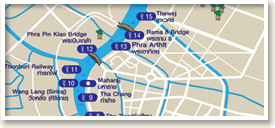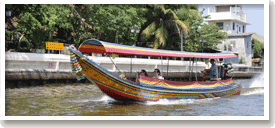



Walking Tour
NEIGHBORHOOD PRANAKORN
1. Phra Arthit Road: Just a doorstep from Riva Surya. Phra Arthit offers a more laidback vibe. Formerly a centre of politics and art during the early days of the city. It now boasts numerous restaurants, stylish cafés and hip bars, set in beautiful old shop houses that retain many period details and authentic wooden shutters.
2. Phra Sumen Fort: This stocky citadel overlooking the river was constructed in 1783 by King Rama 1 and was originally built to protect the city from invasion. One of only two that still remain from a network of forts. It was renovated in 1981. The area around the fort is now a park called Suan Santichaiprakarn and it is a popular destination for those looking to escape the crowds.
3. Banglumpoo Market: The area was originally famous for the many fireflies that lived in the Lumpoo trees that grew in the area. Formerly a major trading centre, the bustling market atmosphere remains thanks to the amazing array of street food – try the traditional local food, Thai dessert and snacks.
4. National Theatre: The first official National Theatre of Thailand was built in 1961 after Silapakorn theatre, traditionally used for Thai cultural performances. The National Theatre typically presents showcases of Thai Khon (masked dance) and other traditional cultural performances.
5. Khao San Road: Established almost 150 years ago, Khao San Road was originally the site of a “milled rice” (Khaosan) market. Nowadays, it has been transformed into a popular destination to shop and hang out for tourists, the numerous street stalls, cheap guest houses, cafés and laid-back bars and clubs that line both sides of the road and the surrounding streets.
6. Rattanakosin Exhibition Hall: Also known as Nitasrattanakosin, this impressive building was renovated in 2008, to help fulfill King Rama 5’s original objective of creating Thailand’s very own version of the Champ Elysees in Rachadamnoen Road.
7. City Pillar Shrine: The original city pillar was built when Bangkok became Thailand’s capital in 1782. It was constructed based on the Brahmin belief that the establishment of the pillar in a favourable position would bring the city good fortune.
To get there: Walk from City Pillar Shrine across to Nah Phra Lan Road. The Palace and the temple entrance is on your left. No sleeveless shirt, shorts, mini-skirts or flip-flops are allowed, though clothes are available for rent. Tickets for the Palace and the Temple are THB 500. Open daily 8.30am-3.30pm but the palace hall is only open on weekdays.
8. The Grand Palace: Construction of this stunning Bangkok landmark began in 1782 when King Rama 1 decided to move his capital across the river from Thonburi. Based on the same plan as his previous palace, it then served as the residence of the first kings of the current Chakri Dynasty and is now divided into three main quarters.
9. Wat Phra Kaeo: Situated in the compound of the Grand Palace, Wat Phra Kaeo, better known as the temple of the Emerald Buddha, was built as a royal temple when Bangkok was founded in 1782. The most important building in the temple grounds is the ordination hall, or ubosot, which houses the Emerald Buddha, Thailand’s most revered religious icon.
10. Wat Pho: Located next to the Grand Palace, Wat Pho is one of the oldest, largest and definitely most significant temples in Bangkok. The royal monastery is perhaps best known for the 46-metre-long Reclining Buddha housed in its Ordination Hall. Wat Pho has also traditionally been a place of education, especially for Thai medicine and massage.
11. Bangkok National Museum: Formerly part of Wang Na Palace, these ornate pavilions have been home to the royal collection of King Rama 4 and other objects of historical interest since 1926. The museum houses three permanent exhibitions: the gallery of Thai history starting from the Sukothai period, the Archaeological and Art History Collections and the Decorative Arts and Ethnological Gallery.
12. Tha Prachan Amulet Market: The Prachan is considered the largest and oldest amulet market in Bangkok. Many Thai Buddhists believe that these religious talismans, often containing images of the Buddha or sacred objects and usually worn around the neck, have special properties of protection and good luck.

Directions to Hotel
From Suvannabhumi airport, get off Express Way at Yommaraj Exit to Pitsanulok Road and drive to the end of the road, turn left to Samsen road, straight on until Banglumpu intersection, turn left to Phra Sumen Road, passing Phra Sumen Fort on the right about 500 metres, Riva Surya is located on the right. For more information, please call +66 2 6335000.
Weather Forecast




